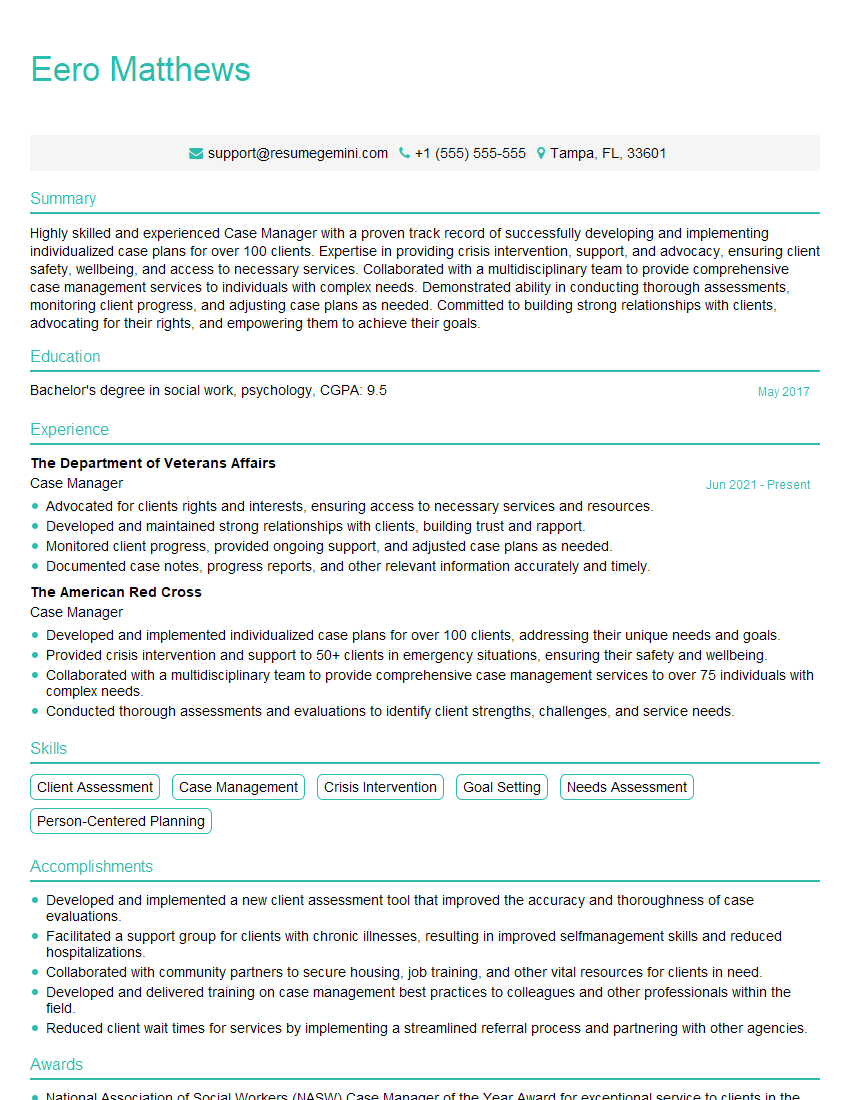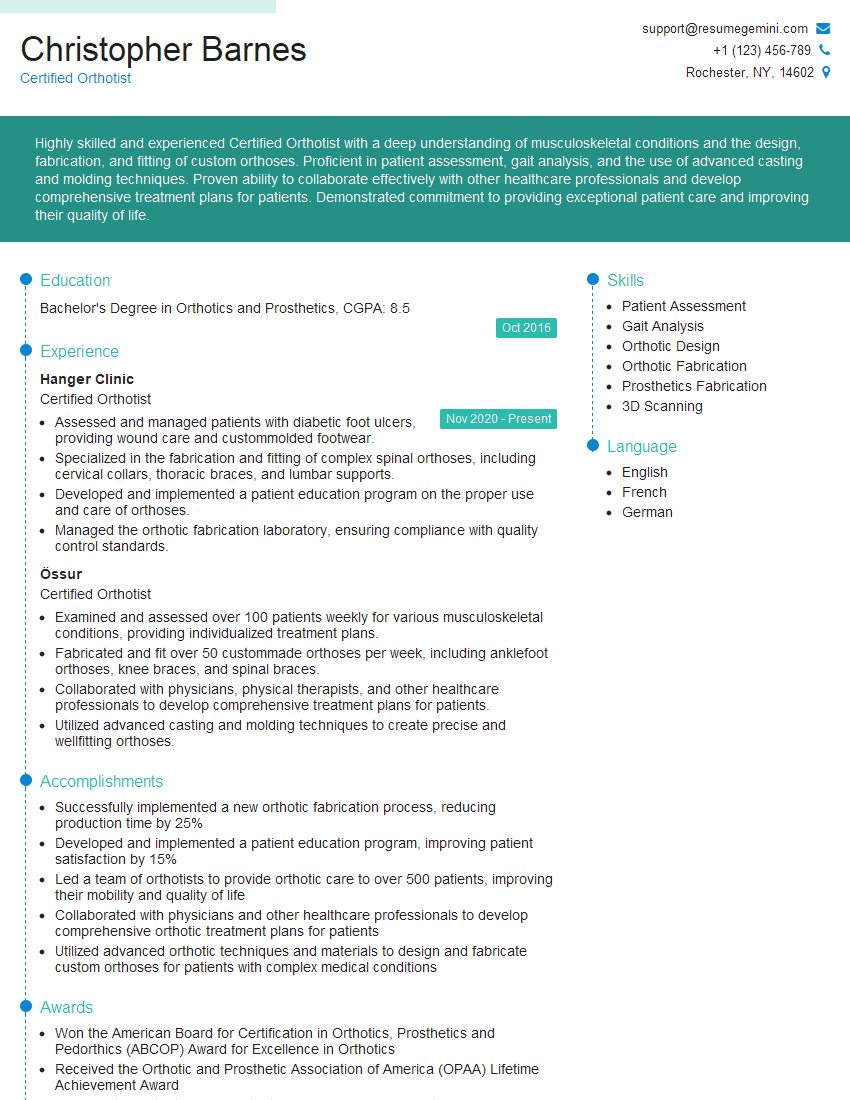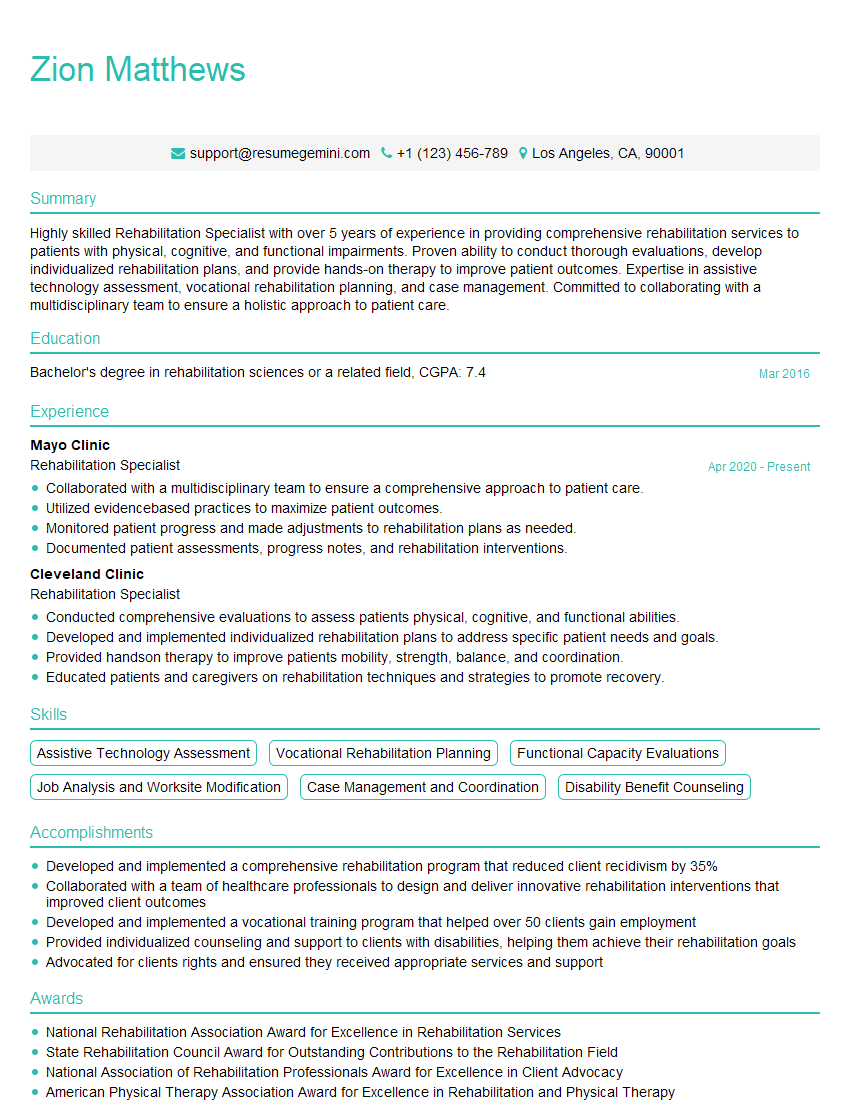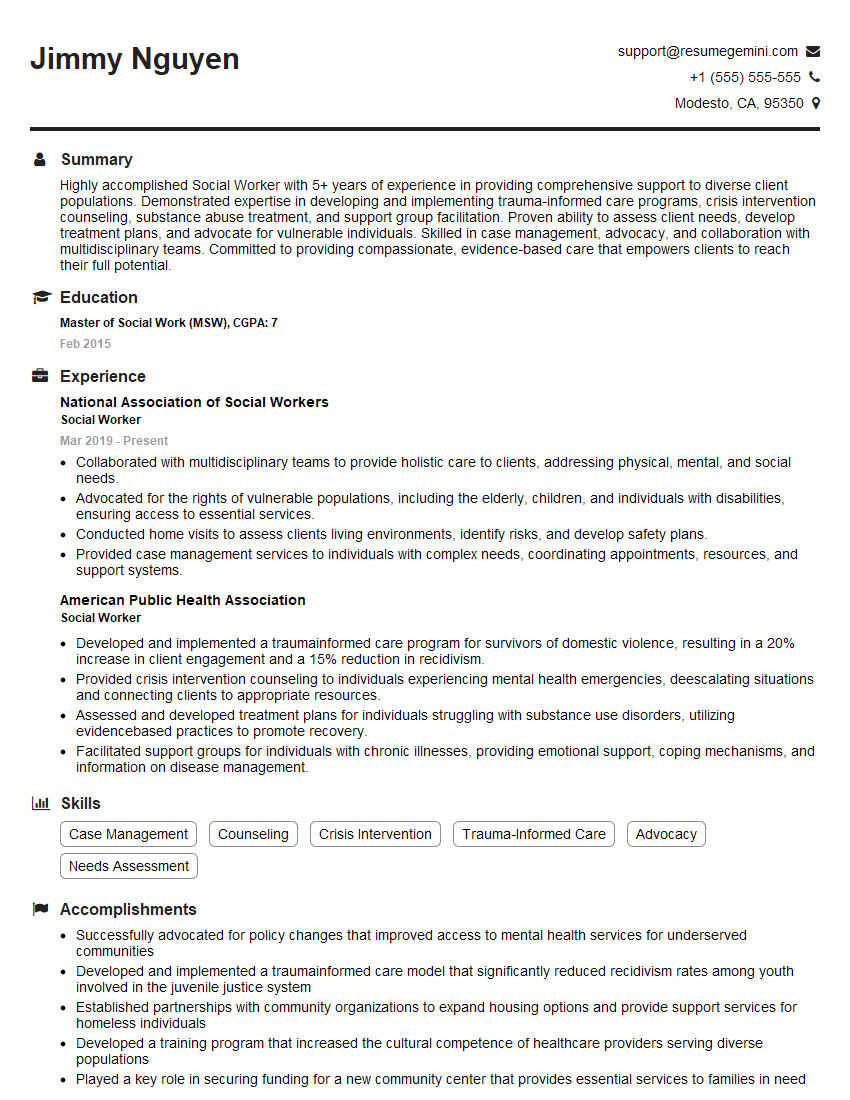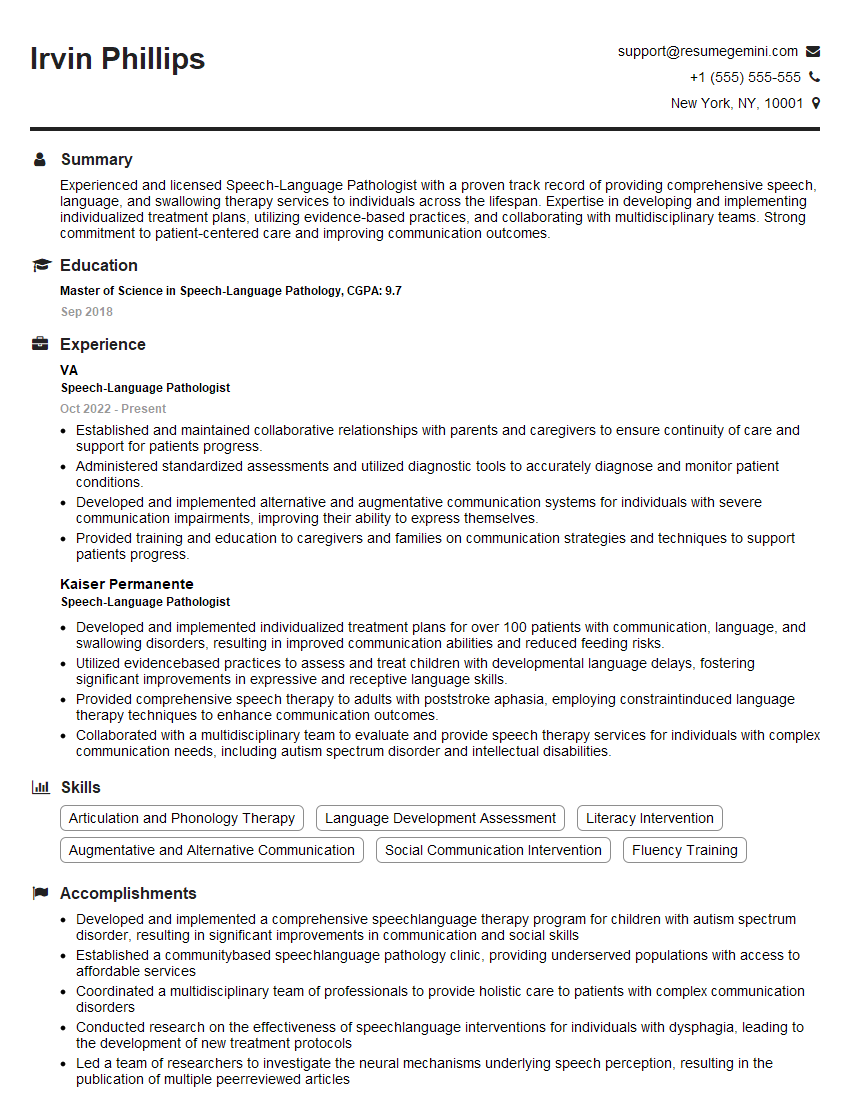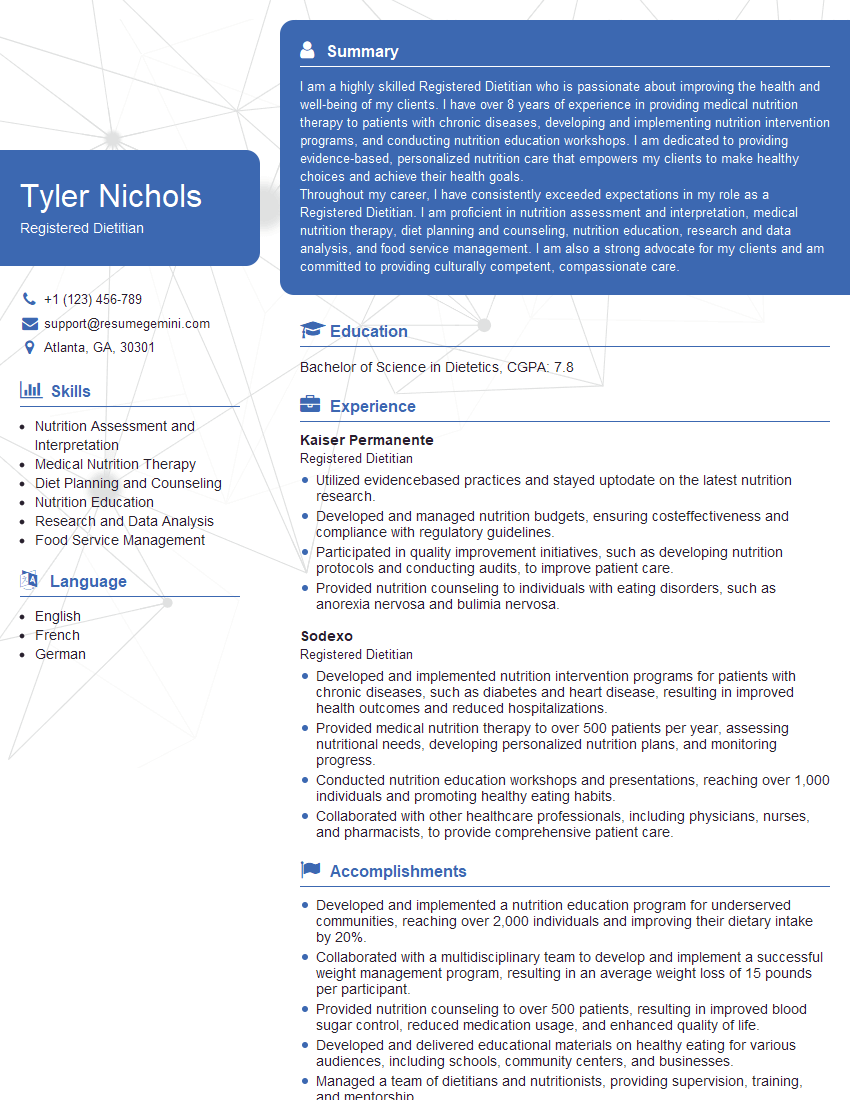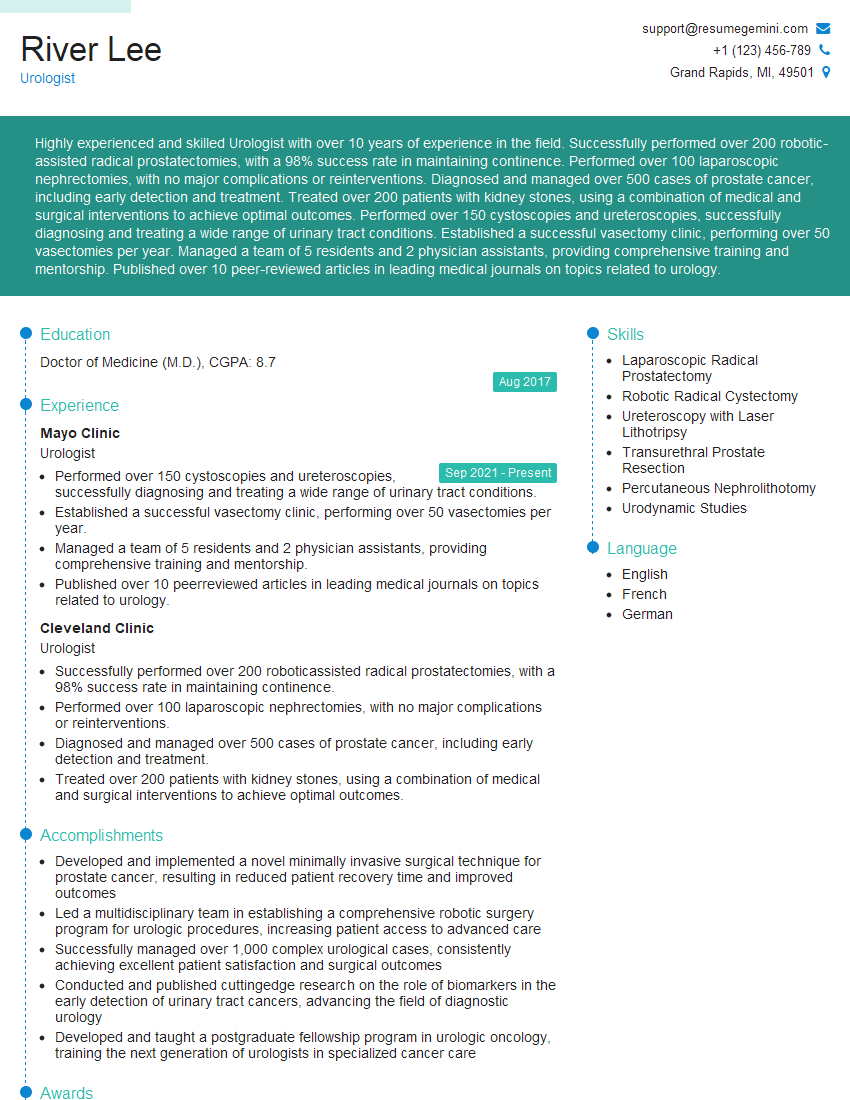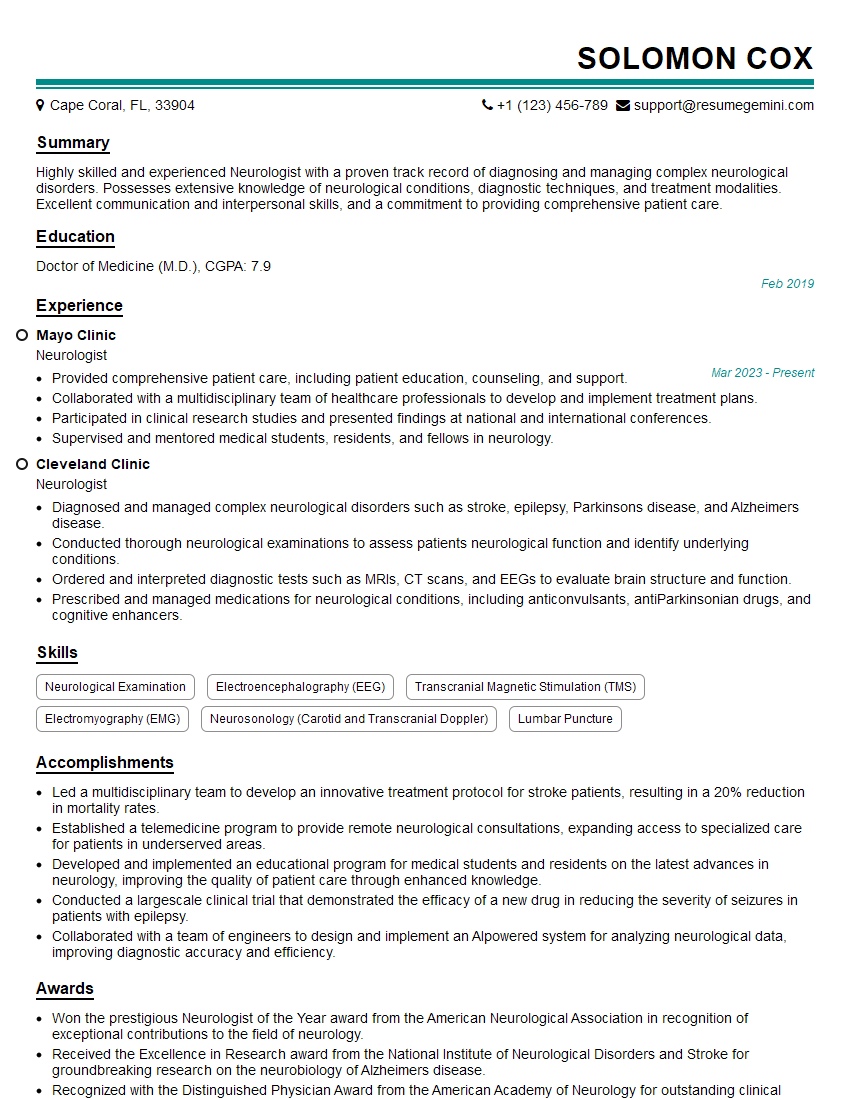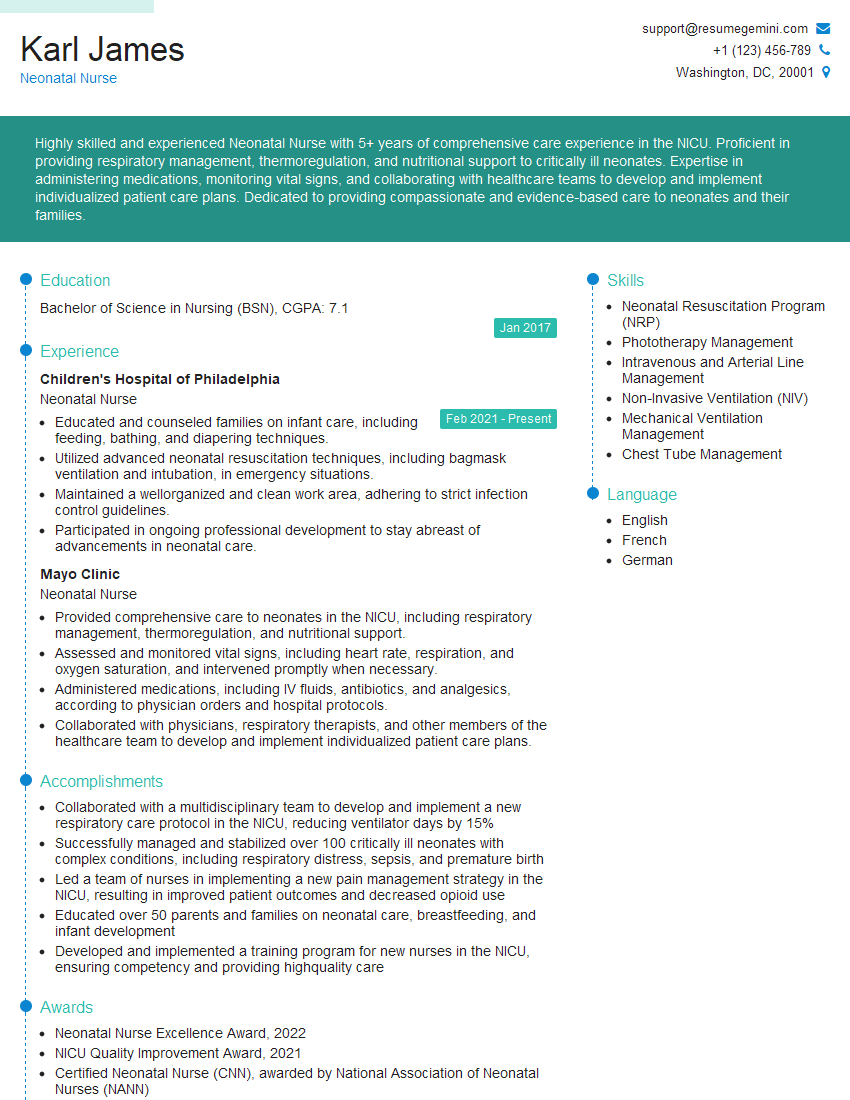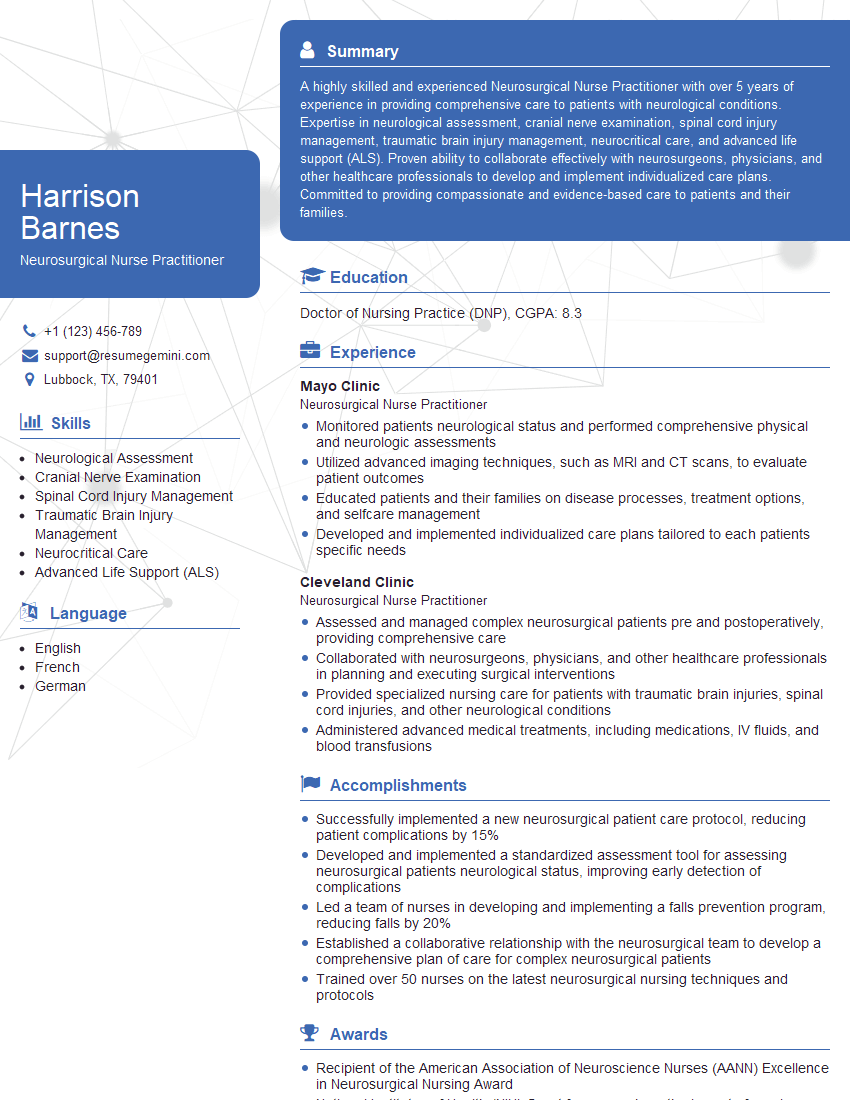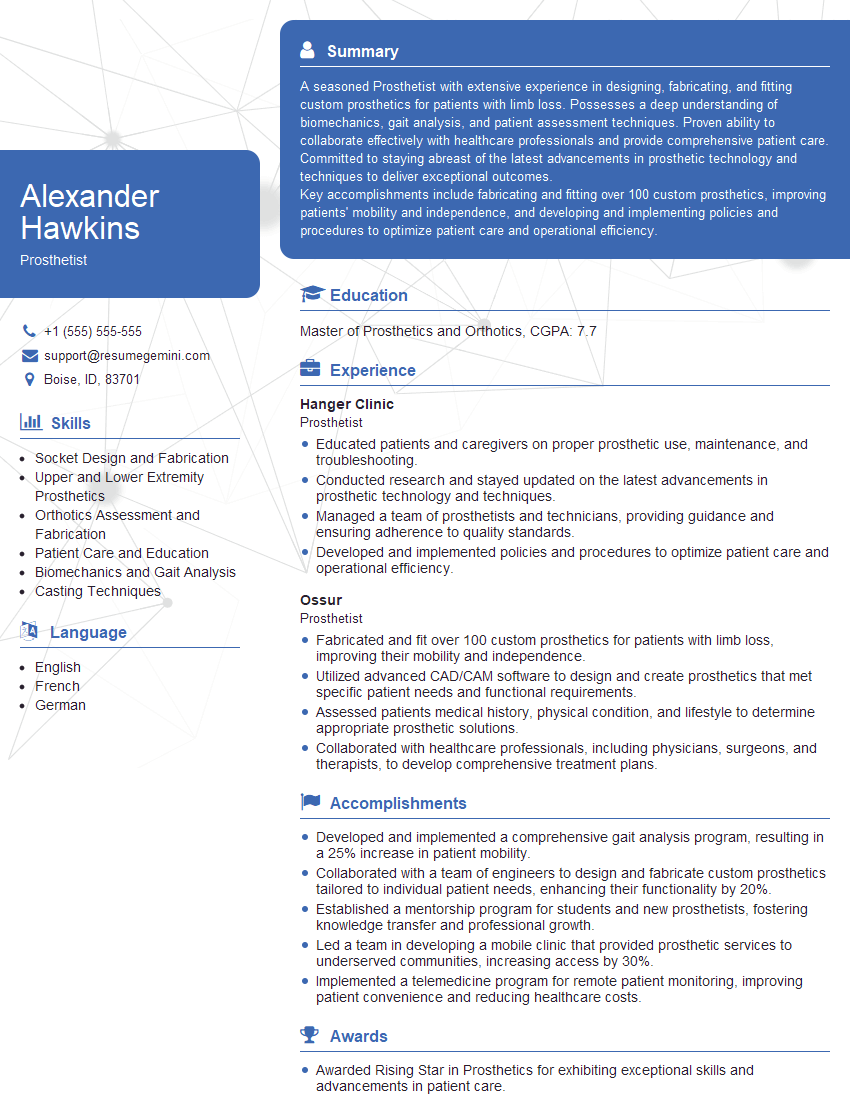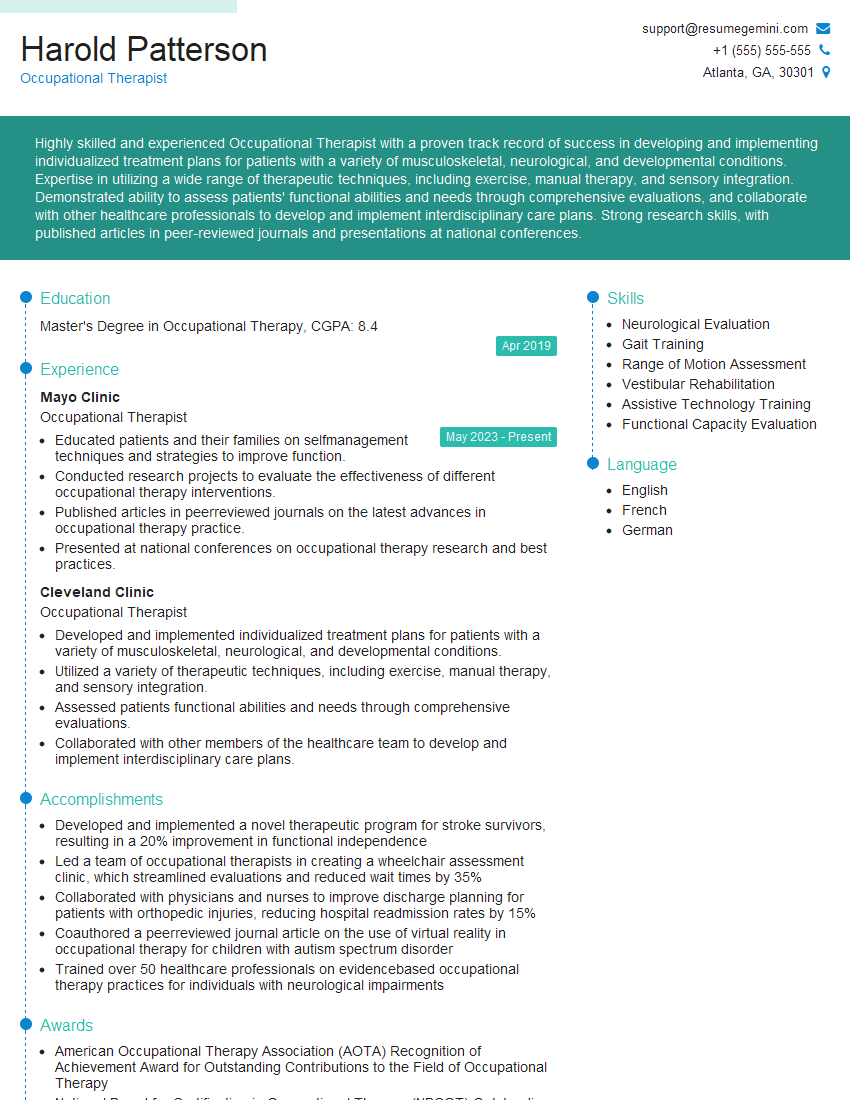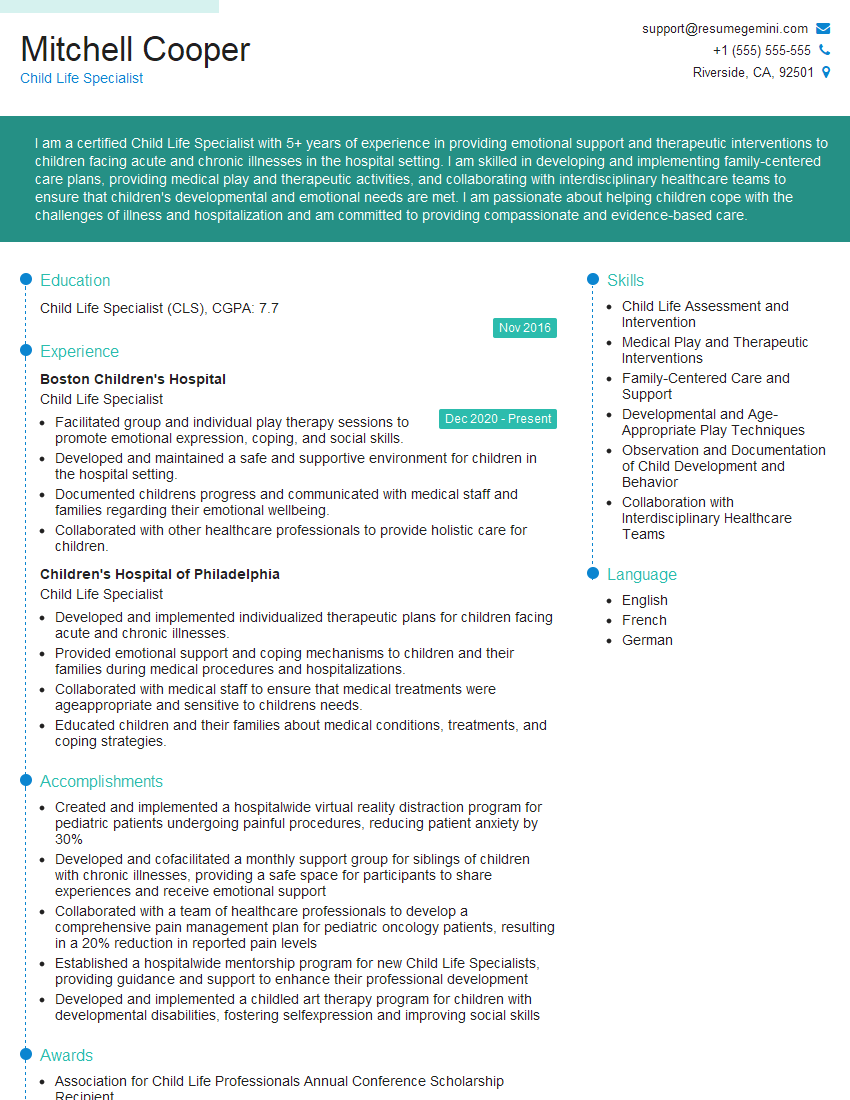Preparation is the key to success in any interview. In this post, we’ll explore crucial Spina Bifida Treatment interview questions and equip you with strategies to craft impactful answers. Whether you’re a beginner or a pro, these tips will elevate your preparation.
Questions Asked in Spina Bifida Treatment Interview
Q 1. Describe the different types of spina bifida and their associated complications.
Spina bifida is a neural tube defect where the spinal cord doesn’t close completely during fetal development. There are three main types:
- Spina bifida occulta: This is the mildest form. A small gap in one or more vertebrae occurs, but the spinal cord and nerves are usually unaffected. Often, there are no outward signs, and many individuals are unaware they have it. Complications are rare, but some might experience skin discoloration or a hairy patch over the affected area.
- Meningocele: In meningocele, the spinal fluid-filled sac (meninges) protrudes through the opening in the vertebrae. The spinal cord itself is usually unaffected. Surgical repair is usually recommended to prevent infection and CSF leakage. Complications are relatively less severe compared to myelomeningocele, but can include nerve damage if the sac is close to the spinal cord.
- Myelomeningocele: This is the most severe type. The spinal cord and nerves protrude through the opening in the vertebrae, forming a sac. This often causes significant neurological impairments, depending on the location and severity of the defect. Complications can be extensive, ranging from paralysis and bowel/bladder dysfunction to hydrocephalus (fluid buildup in the brain) and learning disabilities.
The severity of complications is directly related to the type and location of the defect. The higher the defect on the spine, the more extensive the potential neurological damage.
Q 2. Explain the prenatal diagnosis methods for spina bifida.
Prenatal diagnosis of spina bifida is crucial for timely intervention and management. Methods include:
- Ultrasound: A routine ultrasound scan during pregnancy can often detect structural abnormalities of the spine. This is usually performed between 16 and 20 weeks of gestation. The visualization of the open neural tube is a key diagnostic indicator.
- Maternal Serum Alpha-Fetoprotein (MSAFP) Screening: This blood test measures the level of alpha-fetoprotein, a protein produced by the fetus. Elevated levels can suggest neural tube defects, but this test alone isn’t diagnostic and needs further investigation with ultrasound.
- Amniocentesis: This invasive procedure involves extracting amniotic fluid for analysis. The fluid can be tested for elevated alpha-fetoprotein levels, providing more conclusive evidence. While more accurate than MSAFP, it carries a small risk of miscarriage.
- Chorionic villus sampling (CVS): Similar to amniocentesis, CVS involves obtaining fetal tissue for analysis, offering earlier diagnosis but also carrying a risk of complications.
A combination of these methods is often employed for comprehensive diagnosis. Early detection allows parents to make informed decisions regarding pregnancy management and to prepare for the potential needs of the child post-birth.
Q 3. What are the surgical interventions for myelomeningocele?
Surgical intervention for myelomeningocele is typically performed within 24-48 hours of birth. The primary goal is to protect the exposed neural tissue and prevent infection. The procedure involves:
- Closure of the Sac: The protruding sac is carefully opened, and the spinal cord and nerves are gently replaced into the spinal canal. The surgical team will meticulously assess the neural tissue to ensure as much is placed back in the canal as possible.
- Closure of the Defect: The opening in the vertebrae is closed using surgical techniques and materials. This helps to maintain spinal cord integrity and to prevent further fluid leakage and prevent further damage.
- Shunt Placement (if needed): If hydrocephalus (accumulation of cerebrospinal fluid) is present or suspected, a shunt may be placed during the surgery or shortly thereafter to drain excess fluid from the brain.
Post-operative monitoring is crucial to assess for complications like infection, CSF leakage, and neurological deterioration.
Q 4. Discuss the post-operative care for infants with spina bifida.
Post-operative care for infants with spina bifida is intensive and multidisciplinary, involving a team of specialists. Key aspects include:
- Infection Prevention: Meticulous wound care and monitoring for signs of infection are vital due to the risk of meningitis.
- Hydrocephalus Management: Regular monitoring of head circumference and neurologic status is essential, particularly if a shunt is in place. Shunt malfunctions require immediate attention.
- Pain Management: Pain control is important for comfort and to facilitate rehabilitation.
- Neurological Monitoring: Regular neurological assessments track the infant’s motor function, sensation, and reflexes to evaluate the extent of neurological damage and response to treatment.
- Nutritional Support: Adequate nutrition is critical for growth and development.
- Early Intervention: Physical and occupational therapy should begin as soon as the infant is medically stable to promote motor skill development and functional independence.
Parents receive comprehensive education on caring for their child, including wound care, medication administration, and recognizing signs of complications. Long-term follow-up care is essential to manage the various challenges associated with spina bifida.
Q 5. How do you manage hydrocephalus in spina bifida patients?
Hydrocephalus, a common complication of spina bifida, is managed primarily through the placement of a ventriculoperitoneal (VP) shunt. This is a small tube that drains excess cerebrospinal fluid from the ventricles of the brain to the peritoneal cavity (abdominal area), allowing for its absorption.
Regular monitoring of shunt function is crucial. Signs of shunt malfunction include headache, vomiting, lethargy, and changes in neurological status. If a shunt malfunction is suspected, immediate medical attention is necessary. In some cases, other less common surgical options may be considered.
Beyond surgical intervention, close monitoring of head circumference, neurological examination and imaging studies (like ultrasounds or CT scans) are essential for ongoing management.
Q 6. What are the common orthopedic challenges in spina bifida and their treatment?
Orthopedic challenges are frequent in spina bifida due to muscle weakness, paralysis, and joint deformities. Common problems include:
- Clubfoot: This deformity involves an inward turning of the foot. Treatment involves serial casting, bracing, or surgery.
- Hip Dysplasia: Abnormal development of the hip joint, often requiring bracing, surgery, or both.
- Scoliosis (curvature of the spine): This can be progressive and require bracing, surgery (spinal fusion), or both, depending on the severity.
- Contractures: Tightening of muscles and tendons leading to limited range of motion. Treatment includes stretching exercises, splinting, and surgery.
Orthopedic management aims to improve mobility, prevent further deformities, and enhance quality of life. Regular orthopedic assessments and interventions are vital for successful management. The specific treatment plan depends on the individual’s specific needs and the severity of the deformities.
Q 7. Explain the role of physical and occupational therapy in spina bifida management.
Physical and occupational therapy play a pivotal role in spina bifida management, focusing on maximizing functional independence and quality of life.
Physical therapy focuses on improving motor skills, muscle strength, and range of motion. Therapists develop individualized exercise programs to address specific needs, such as improving mobility, balance, and coordination. They teach adaptive techniques for activities of daily living.
Occupational therapy helps individuals develop skills for daily living, such as dressing, eating, and using adaptive equipment. They address fine motor skills and cognitive function, while focusing on assistive devices and environmental modifications to promote independence.
Both therapies are often started early in life and are a lifelong component of care. The therapists work closely with the medical team to ensure the child receives a comprehensive and coordinated care plan. They also assist families in learning how to implement therapeutic interventions at home.
Q 8. Describe the importance of bowel and bladder management in spina bifida.
Bowel and bladder dysfunction are very common in individuals with spina bifida, stemming from the incomplete development of the spinal cord and nerves controlling these functions. Effective management is crucial for maintaining their health, dignity, and quality of life. It prevents complications like urinary tract infections (UTIs), kidney damage, bowel impactions, and skin problems.
Management strategies are tailored to the individual’s specific needs and may include:
- Clean intermittent catheterization (CIC): This involves regularly draining the bladder using a sterile catheter. It’s a self-catheterization technique taught to the patient and caregivers, empowering them to manage their bladder health independently.
- Bowel programs: These are carefully planned routines involving diet modifications, medication (e.g., stool softeners), and manual evacuation techniques to ensure regular, predictable bowel movements. The goal is to prevent constipation and incontinence.
- Medication: Medications like antispasmodics can help manage bladder spasms and improve bladder control. Other medications address constipation.
- Surgery: In some cases, surgery may be needed to correct anatomical abnormalities or create a more functional urinary or bowel system. For example, a vesicostomy, where a new opening is surgically created to drain urine from the bladder, may be necessary.
Regular monitoring for UTIs and bowel issues is vital. Education and support for both the individual and their family are essential components of a successful bowel and bladder management program. Think of it like learning a new skill – it takes practice, patience, and ongoing support.
Q 9. How do you address learning disabilities associated with spina bifida?
Learning disabilities are common in spina bifida, varying widely in severity depending on the location and extent of the neural tube defect. Addressing these disabilities requires a multi-faceted approach, involving early intervention and specialized educational support.
Strategies include:
- Early identification and intervention: Developmental screenings and assessments are crucial to identify learning challenges as early as possible. Early intervention significantly improves outcomes.
- Individualized Education Programs (IEPs): These plans tailor the educational approach to meet the individual’s specific needs, providing appropriate accommodations and support in the classroom. This may include assistive technology or modified curriculum.
- Specialized therapies: Occupational therapy, physical therapy, and speech therapy can help address specific challenges with fine motor skills, gross motor skills, and communication.
- Inclusive education: Creating a supportive and inclusive classroom environment promotes social and emotional development. This allows children with spina bifida to feel accepted and participate fully.
- Assistive technology: Devices such as computers with adaptive software, communication aids, and mobility aids can significantly enhance learning and independence.
For instance, a child with mild cognitive delays might benefit from extra tutoring and assistive technology, while a child with more significant learning disabilities may require specialized schooling and more intensive support services. The key is individualized care and ongoing assessment to adapt the approach as the child grows and develops.
Q 10. What are the long-term health implications for individuals with spina bifida?
Long-term health implications for individuals with spina bifida are diverse and can significantly impact their lives. These implications often require lifelong management and may include:
- Neurological issues: Ongoing challenges with motor control, sensation, and bowel/bladder function are common. These may worsen over time.
- Orthopedic problems: Scoliosis (curvature of the spine), hip dysplasia, and joint contractures are frequent and often require ongoing physical therapy, bracing, or surgery.
- Hydrocephalus: This build-up of fluid in the brain can lead to increased intracranial pressure, requiring ongoing monitoring and potential shunt revisions.
- Latex allergy: Individuals with spina bifida have a higher risk of developing a severe latex allergy, requiring careful avoidance of latex products.
- Urinary tract infections (UTIs): Recurrent UTIs can lead to kidney damage if not properly managed.
- Skin breakdown: Impaired sensation can lead to pressure sores, necessitating careful skin care and preventative measures.
- Tethered cord syndrome: This occurs when the spinal cord is abnormally attached, requiring surgical correction to prevent further neurological damage.
The severity and specific implications vary greatly depending on the level and severity of the spina bifida. Regular medical checkups are essential for early detection and management of complications. A proactive and comprehensive approach to healthcare throughout life is crucial.
Q 11. Describe the role of a multidisciplinary team in spina bifida care.
A multidisciplinary team is essential for comprehensive spina bifida care. No single specialist can address all the complexities involved. The team typically includes:
- Neurosurgeon: Manages hydrocephalus and other neurological issues, performing surgeries as needed.
- Orthopedic surgeon: Addresses orthopedic problems like scoliosis and joint contractures.
- Urologist: Manages bowel and bladder dysfunction.
- Neurologist: Monitors neurological function and addresses any neurological complications.
- Physical therapist: Works on mobility, strength, and motor skills.
- Occupational therapist: Focuses on daily living skills and adaptive equipment.
- Speech therapist: Addresses any communication difficulties.
- Pediatrician or family physician: Provides overall medical care and coordinates the team.
- Social worker: Provides support and resources for the family.
- Nurse: Provides education, support, and monitoring.
This collaborative approach ensures that every aspect of the individual’s needs is addressed, fostering a holistic and effective care plan. Regular team meetings help to coordinate care and ensure consistent communication among professionals.
Q 12. How do you assess the neurological function in a child with spina bifida?
Assessing neurological function in a child with spina bifida involves a thorough evaluation of motor skills, sensory function, and reflexes. The level of the spinal defect determines the extent of neurological involvement. The assessment typically includes:
- Physical examination: A detailed examination assesses muscle strength, tone, reflexes, and range of motion. This helps determine the level of spinal cord involvement.
- Sensory testing: Assessing touch, temperature, pain, and proprioception (body awareness) helps map the areas affected by reduced sensation.
- Imaging studies: Ultrasound, MRI, and CT scans provide detailed images of the spinal cord and brain, allowing for better visualization of the defect and any associated abnormalities.
- Developmental assessments: Standardized tests evaluate the child’s motor, cognitive, and language development, highlighting strengths and areas requiring intervention.
- Electrodiagnostic studies (EMG/NCS): In some cases, these studies help assess nerve function and identify potential problems.
For example, a child with a low lumbar lesion might have weakness in their legs but normal upper body function, while a child with a high thoracic lesion may have more significant motor and sensory deficits affecting their arms and legs. The assessment helps establish a baseline, guide treatment decisions, and track progress over time.
Q 13. What are the common complications of shunts used to treat hydrocephalus?
Shunts are surgically implanted devices that drain excess cerebrospinal fluid (CSF) from the brain to prevent hydrocephalus. While life-saving, they are prone to complications. Common issues include:
- Infection: Infection at the shunt site or within the shunt itself is a serious complication requiring treatment with antibiotics or shunt removal and replacement.
- Obstruction: The shunt tubing can become blocked, causing a build-up of CSF and increased intracranial pressure. This requires surgical intervention to clear the obstruction or replace the shunt.
- Malfunction: The shunt valve may fail to function properly, leading to either over-drainage or under-drainage of CSF. This necessitates shunt revision.
- Shunt migration: The shunt tubing can shift from its original position, impairing its function and requiring surgical repositioning.
- Bleeding: Bleeding around the shunt site can occur during surgery or post-operatively.
Regular monitoring for shunt malfunction is crucial. Parents and caregivers need to be vigilant for signs of increased intracranial pressure, such as headaches, vomiting, irritability, and changes in behavior. Prompt medical attention is vital to prevent serious complications.
Q 14. Explain the different types of orthotic devices used in spina bifida.
Orthotic devices play a vital role in supporting mobility and preventing deformities in children with spina bifida. The type of orthotic used depends on the level and severity of the spinal defect, as well as the individual’s specific needs and abilities.
Examples include:
- Ankle-foot orthoses (AFOs): These braces support the ankles and feet, improving balance and gait. They can be used for mild to moderate lower extremity weakness.
- Knee-ankle-foot orthoses (KAFOs): These provide more significant support for the knees, ankles, and feet, offering stability and assistance for ambulation. They are used for more severe lower extremity weakness.
- Hip-knee-ankle-foot orthoses (HKAFOs): These provide support for the hips, knees, ankles, and feet, used in cases of significant lower extremity weakness or paralysis. They often require significant assistance for ambulation.
- Custom-made orthoses: These devices are tailored to the individual’s specific needs and anatomical characteristics, providing optimal support and functionality. They may incorporate various components depending on the specific needs.
- Wheelchairs: For individuals with significant mobility limitations, a wheelchair provides independence and mobility.
The selection of appropriate orthotics is made in collaboration with the orthopedic surgeon, physical therapist, and the individual or their family. Regular adjustments and follow-up care are crucial to ensure proper fit and effectiveness.
Q 15. What are the psychological and emotional considerations for patients with spina bifida?
Spina bifida significantly impacts the psychological and emotional well-being of patients and their families. The challenges are multifaceted and evolve throughout life.
- Body image and self-esteem: Physical differences, mobility limitations, and potential need for assistive devices can significantly affect a child’s self-perception and confidence. For example, a child may struggle with participation in sports or social activities, leading to feelings of isolation and inadequacy.
- Anxiety and depression: The chronic nature of spina bifida, potential for complications (like recurring infections or shunt malfunctions), and the need for ongoing medical care can lead to significant anxiety and depression in both children and adults.
- Social integration and relationships: Social stigma, difficulties with mobility, and potential learning disabilities can affect social interactions and the development of friendships. Building supportive relationships and fostering a sense of belonging is crucial.
- Family dynamics: Caring for a child with spina bifida places immense demands on families. Parents may experience stress, guilt, and financial burden. Sibling relationships can also be affected, with siblings potentially feeling neglected or resentful.
- Cognitive and learning challenges: Some individuals with spina bifida may experience learning disabilities or cognitive impairments, which can impact their academic performance, independence, and self-confidence. Early identification and appropriate support are essential.
Addressing these emotional and psychological challenges requires a multidisciplinary approach involving psychologists, therapists, social workers, and supportive family members. Strategies include individual and family therapy, support groups, and adaptive coping mechanisms.
Career Expert Tips:
- Ace those interviews! Prepare effectively by reviewing the Top 50 Most Common Interview Questions on ResumeGemini.
- Navigate your job search with confidence! Explore a wide range of Career Tips on ResumeGemini. Learn about common challenges and recommendations to overcome them.
- Craft the perfect resume! Master the Art of Resume Writing with ResumeGemini’s guide. Showcase your unique qualifications and achievements effectively.
- Don’t miss out on holiday savings! Build your dream resume with ResumeGemini’s ATS optimized templates.
Q 16. How do you counsel parents of a newborn with spina bifida?
Counseling parents of a newborn with spina bifida is a delicate and crucial process requiring empathy, patience, and a thorough understanding of the condition.
My approach involves providing accurate information in a sensitive and compassionate manner. I start by explaining the diagnosis in clear, understandable terms, avoiding medical jargon whenever possible. I then explain the specific type and severity of the spina bifida, outlining the potential complications and treatment options. It’s vital to emphasize the child’s strengths and potential, avoiding language that suggests limitations or hopelessness. I always highlight the significant advances in spina bifida treatment, and the potential for a fulfilling life.
I encourage parents to ask questions and openly express their emotions—fear, grief, and uncertainty are all normal reactions. I offer ongoing support, connecting them with relevant resources such as support groups, therapists, and specialists. Collaboration with the whole family is critical, ensuring everyone understands the child’s needs and treatment plan.
Furthermore, I help parents to develop realistic expectations, empowering them to actively participate in their child’s care. I emphasize the importance of early intervention, as prompt treatment can significantly improve outcomes. The long-term goal is to foster a positive and supportive family environment that allows the child to thrive and reach their full potential.
Q 17. Describe your experience with managing infections in spina bifida patients.
Managing infections in spina bifida patients is a critical aspect of their care, as they are at increased risk due to neurogenic bladder and bowel dysfunction. These patients are particularly susceptible to urinary tract infections (UTIs), skin infections, and meningitis.
My experience involves a proactive approach, focusing on preventative measures such as regular bladder and bowel management programs, meticulous skin care, and prompt treatment of any signs of infection. Early recognition of symptoms is vital. For UTIs, we utilize urinalysis and urine culture to identify the causative bacteria and prescribe appropriate antibiotics. Skin infections are treated with topical or systemic antibiotics, depending on severity. Meningitis, a life-threatening complication, necessitates immediate hospitalization and intravenous antibiotics.
I routinely monitor patients for signs of infection, including fever, changes in behavior, and changes in urine or stool. We use prophylactic antibiotics in high-risk situations, such as during surgical procedures. Regular follow-up appointments and close communication between families and healthcare providers are essential in identifying and managing infections promptly. In my experience, early intervention and adherence to prescribed treatments significantly improve outcomes and minimize the risk of serious complications.
Q 18. What are the current research advancements in spina bifida treatment?
Research in spina bifida treatment is constantly evolving, aiming to improve outcomes and enhance quality of life. Recent advancements include:
- Prenatal surgery: Fetoscopic surgery performed in utero has shown promising results in reducing the severity of myelomeningocele, a common type of spina bifida. This procedure aims to repair the defect before birth, minimizing neurological damage.
- Stem cell therapy: Ongoing research explores the potential of stem cells to promote nerve regeneration and improve neurological function in individuals with spina bifida. While still in early stages, this holds immense promise for future treatment.
- Advanced imaging techniques: Improved neuroimaging techniques provide more detailed information about the extent of spinal cord damage and brain development, guiding treatment strategies and enhancing diagnosis.
- Robotics and assistive technology: Developments in robotics and assistive technology offer greater mobility and independence for individuals with spina bifida, improving their participation in daily activities and social interactions. Exoskeletons and other advanced devices are transforming lives.
- Targeted therapies: Research focuses on developing therapies that address specific complications of spina bifida, such as bladder dysfunction and hydrocephalus (fluid buildup in the brain).
These advancements offer renewed hope for individuals with spina bifida, promising a future with improved functional outcomes and enhanced quality of life. Staying abreast of these developments is critical to providing optimal patient care.
Q 19. Explain the importance of early intervention in spina bifida.
Early intervention in spina bifida is crucial because it significantly impacts a child’s long-term development and well-being. The earlier interventions begin, the better the chances of maximizing the child’s potential.
Early intervention encompasses a multifaceted approach including:
- Surgical repair of myelomeningocele: Surgical closure of the myelomeningocele is typically done soon after birth to protect the exposed spinal cord and reduce the risk of infection. The timing is crucial.
- Shunt placement for hydrocephalus: Many children with spina bifida develop hydrocephalus, requiring a shunt to drain excess fluid from the brain. Early diagnosis and placement of the shunt prevent brain damage.
- Physical therapy: Early physical therapy helps to strengthen muscles, improve mobility, and prevent contractures. This helps to maintain flexibility and improve movement skills.
- Occupational therapy: Occupational therapy helps children develop adaptive skills for daily living tasks, such as eating, dressing, and writing.
- Bowel and bladder programs: Implementing bowel and bladder management programs early on helps prevent infections and promotes continence.
- Developmental stimulation: Early intervention programs provide appropriate stimulation to support cognitive and language development.
Early intervention programs foster a supportive environment for both the child and family, maximizing opportunities for growth and independence. The benefits extend across physical, cognitive, social, and emotional domains.
Q 20. How do you assess the effectiveness of treatment interventions for spina bifida?
Assessing the effectiveness of treatment interventions for spina bifida requires a multidimensional approach, utilizing various assessment tools and measures.
We utilize a combination of objective and subjective measures including:
- Neurological examinations: Regular neurological assessments help track the child’s motor function, sensation, and reflexes.
- Functional assessments: These assessments measure a child’s ability to perform daily living tasks, such as walking, dressing, and feeding. Examples include standardized scales such as the Gross Motor Function Measure (GMFM) and the Pediatric Evaluation of Disability Inventory (PEDI).
- Cognitive and educational assessments: These help to track the child’s cognitive development and educational progress.
- Urodynamic studies: These studies assess bladder function and identify any abnormalities.
- Quality of life questionnaires: These instruments measure the child’s and family’s overall well-being and satisfaction with treatment. Examples include the Pediatric Quality of Life Inventory (PedsQL).
- Regular monitoring of complications: Close monitoring of potential complications like infections, shunt malfunction, and pressure sores is crucial in evaluating the effectiveness of treatment interventions.
By combining these different assessments, we can develop a comprehensive understanding of the child’s progress and the effectiveness of the implemented treatment strategies. This data helps to guide ongoing management, allowing for modifications to the treatment plan as needed.
Q 21. Describe your experience with different types of shunt revisions.
Shunt revisions are sometimes necessary in patients with spina bifida due to shunt malfunction, infection, or obstruction. My experience encompasses various types of revisions.
These include:
- Revision of shunt tubing: This involves replacing sections of the shunt tubing if it becomes blocked, fractured, or infected. This often includes replacing the distal catheter if necessary.
- Revision of shunt valve: If the shunt valve malfunctions, such as becoming obstructed or failing to regulate fluid flow, it needs revision or replacement.
- Revision of shunt reservoir: The reservoir, which is often placed under the skin, may require revision if it becomes infected or displaced.
- Shunt removal and replacement: In some cases, the entire shunt system may need to be removed and replaced. This is typically due to recurrent infections or significant dysfunction.
Each revision requires careful planning and surgical precision. Pre-operative imaging studies are crucial to assess the existing shunt placement and identify the cause of the malfunction. Post-operative monitoring is equally important, ensuring proper shunt function and monitoring for complications such as infection or bleeding. Close collaboration with neurosurgical colleagues is always necessary, and choosing the appropriate shunt system is a critical part of the decision-making process to optimize the outcomes for each patient.
Q 22. Explain your approach to managing skin breakdown in patients with spina bifida.
Managing skin breakdown is paramount in spina bifida care due to reduced sensation and mobility. Our approach is multifaceted and proactive, focusing on prevention and early intervention.
- Regular Skin Checks: We perform meticulous daily skin inspections, paying close attention to pressure points like the buttocks, heels, and sacrum. Any redness, warmth, or changes in skin integrity are immediately addressed.
- Pressure Relief: Frequent repositioning is crucial. We use specialized cushions, mattresses, and supportive devices to distribute pressure evenly and minimize friction. For example, we might use a wheelchair with pressure-relieving features or recommend alternating pressure mattresses.
- Proper Hygiene: Maintaining meticulous hygiene is essential. Gentle cleansing with mild soap and water, followed by thorough drying, prevents skin irritation and infection. We educate patients and caregivers about the importance of avoiding harsh soaps or scrubbing.
- Moisture Management: We address incontinence issues promptly with appropriate absorbent products and skin barrier creams to prevent moisture-related skin damage. This often involves working closely with a continence nurse.
- Nutritional Support: Adequate nutrition is vital for wound healing. We may consult with a dietitian to ensure the patient receives sufficient protein and other essential nutrients.
- Wound Care: Should a pressure sore develop, we employ appropriate wound care techniques, such as debridement, dressing changes, and possibly topical treatments, guided by the wound’s stage and characteristics.
We emphasize a team approach involving nurses, physicians, physical therapists, and potentially specialists like wound care nurses or surgeons to ensure comprehensive care.
Q 23. What are the ethical considerations in managing spina bifida?
Ethical considerations in spina bifida management are complex and multifaceted. They center on promoting patient autonomy, respecting their wishes, and ensuring equitable access to quality care.
- Informed Consent: We ensure patients and their families fully understand the treatment options, potential benefits, and risks before making any decisions. This is especially crucial when considering surgery or other invasive procedures.
- Quality of Life: Balancing the potential for medical interventions with the overall quality of life is a key ethical consideration. We work collaboratively with the patient and family to define their goals and prioritize interventions that align with these goals.
- Resource Allocation: Spina bifida care is resource-intensive. Ethical considerations arise in ensuring equitable access to specialized services, therapies, and equipment, regardless of socioeconomic status.
- Genetic Counseling: Ethical considerations arise when discussing genetic implications with families, including carrier testing and reproductive options. This requires sensitivity and respect for their beliefs.
- End-of-Life Care: In some cases, patients may face life-threatening complications. Ethical considerations include honest discussions about prognosis, pain management, and end-of-life choices, respecting patient autonomy and dignity.
We work within a framework of shared decision-making, ensuring open communication, transparency, and respect for individual values and preferences.
Q 24. How do you educate patients and families about spina bifida management?
Educating patients and families is a crucial ongoing process that starts from diagnosis and continues throughout their lives. Our approach employs various methods:
- Individualized Education Plans: We create personalized educational plans tailored to each family’s needs and learning style. This includes written materials, visual aids, and videos.
- Interactive Sessions: We conduct regular sessions to explain the condition, treatment options, and potential complications. We encourage questions and address concerns openly and honestly.
- Support Groups: Connecting families with support groups allows them to share experiences, learn from others, and feel less isolated.
- Demonstrations and Hands-on Training: We provide practical demonstrations on techniques such as catheterization, medication administration, and skin care, empowering patients and caregivers to manage their condition effectively.
- Follow-up and Reinforcement: Regular follow-up appointments allow us to reinforce learning, address new challenges, and make adjustments to the management plan as needed.
- Collaboration with Other Professionals: We work with occupational therapists, physical therapists, and other specialists to ensure a comprehensive and coordinated approach to education.
We use plain language, avoiding medical jargon, and ensure information is accessible and easy to understand.
Q 25. Describe a challenging case you encountered related to spina bifida and how you handled it.
One challenging case involved a young adult with a high-level myelomeningocele and severe hydrocephalus, who developed recurrent shunt infections and significant mobility limitations. He had experienced multiple surgeries, leading to significant physical and emotional trauma.
Initially, his focus was solely on managing his medical complications. However, our team recognized the importance of addressing his social and emotional needs to improve his quality of life. We collaborated with a psychologist to help him cope with the physical challenges and emotional burden.
We also introduced him to adaptive sports programs and vocational rehabilitation services. This holistic approach, incorporating physical therapy, occupational therapy, and psychosocial support, resulted in a significant improvement in his overall well-being, independence, and quality of life. He learned to use a wheelchair more effectively, engaged more in social activities, and successfully pursued a vocational training program. This case highlighted the need for a comprehensive, holistic approach encompassing physical, emotional, and social aspects of care.
Q 26. What are the potential risks and benefits of surgical intervention for spina bifida?
Surgical intervention for spina bifida can involve various procedures, each carrying its own set of risks and benefits.
- Fetal Surgery: This involves surgical repair of the myelomeningocele before birth. Benefits: May reduce the severity of neurological deficits. Risks: Premature delivery, surgical complications for the mother and fetus.
- Shunt Placement: This procedure addresses hydrocephalus by diverting excess cerebrospinal fluid. Benefits: Prevents brain damage from increased pressure. Risks: Infection, blockage, malfunction of the shunt.
- Closure of Myelomeningocele: This involves closing the opening in the spine. Benefits: Prevents infection, reduces risk of cerebrospinal fluid leaks. Risks: Neurological damage, surgical complications.
- Orthopedic Surgeries: These may be needed to address musculoskeletal deformities. Benefits: Improves mobility and function. Risks: Infection, nonunion of bone, limitations in movement.
The decision to proceed with surgery requires careful consideration of the individual patient’s condition, potential benefits, and risks. We conduct a thorough assessment and involve the patient and their family in a shared decision-making process.
Q 27. How do you ensure patient and family compliance with the treatment plan?
Ensuring compliance with the treatment plan is crucial for successful spina bifida management. We utilize several strategies:
- Building Trust and Rapport: Establishing a strong doctor-patient relationship is paramount. We listen to patients’ concerns, address them empathetically, and provide clear, concise explanations.
- Shared Decision-Making: Involving patients and families in the decision-making process fosters ownership and commitment to the treatment plan. We actively seek their input and preferences.
- Setting Realistic Goals: We establish attainable goals that are tailored to the individual’s abilities and limitations. This prevents feelings of frustration and enhances motivation.
- Regular Follow-up Appointments: Scheduled appointments allow for monitoring progress, addressing challenges, and making necessary adjustments to the plan.
- Home Visits: Home visits can be valuable, especially for families facing challenges with medication administration, catheterization, or other aspects of care.
- Multidisciplinary Team Approach: Collaborating with other healthcare professionals such as nurses, physical therapists, and social workers provides comprehensive support and assistance.
- Educational Materials and Resources: Providing easily accessible information empowers patients and families to better understand and manage their condition.
We continuously assess and adapt our approach based on individual needs and circumstances, ensuring we provide the best possible support.
Q 28. What are your strategies for promoting independence and quality of life in spina bifida patients?
Promoting independence and quality of life is a central goal in spina bifida care. Our strategies focus on:
- Early Intervention: Starting therapies early helps maximize functional capabilities and independence. This includes physical, occupational, and speech therapy as needed.
- Assistive Devices: Providing appropriate assistive devices, such as wheelchairs, braces, and adaptive equipment, enhances mobility and independence.
- Adaptive Techniques: We teach patients and caregivers adaptive techniques for daily living tasks, making them easier and more manageable.
- Education and Vocational Training: Access to education and vocational training enables participation in the workforce and fosters independence.
- Social Inclusion: Promoting social participation through support groups and community involvement combats isolation and enhances quality of life.
- Individualized Plans: We develop individual plans reflecting unique needs and goals, ensuring tailored support and promoting a sense of control.
- Regular Monitoring and Adjustments: Continuous monitoring and appropriate adjustments to care plans are essential for improving quality of life.
Our goal is to equip patients and families with the knowledge, skills, and support they need to live fulfilling and independent lives.
Key Topics to Learn for Spina Bifida Treatment Interview
- Types of Spina Bifida: Understanding the different classifications (myelomeningocele, meningocele, occulta) and their associated implications for treatment.
- Prenatal Diagnosis and Management: Knowledge of screening methods, fetal surgery options, and the role of multidisciplinary teams in prenatal care.
- Surgical Interventions: Familiarity with surgical techniques for closure of myelomeningocele, shunt placement, and other corrective procedures. Understanding the risks and benefits of each.
- Post-Surgical Care and Rehabilitation: Comprehensive understanding of physical therapy, occupational therapy, and other rehabilitative strategies to maximize functional outcomes.
- Medical Management of Complications: Knowledge of the common complications (hydrocephalus, tethered cord syndrome, Chiari malformation) and their management strategies, including medication and further surgical intervention.
- Orthopedic Management: Addressing musculoskeletal issues like scoliosis, clubfoot, and hip dysplasia; understanding bracing and surgical options.
- Neurological Assessment and Management: Ability to interpret neurological examinations and understand the implications for treatment planning and functional goals.
- Bowel and Bladder Management: Strategies for managing bowel and bladder dysfunction, including clean intermittent catheterization and bowel programs.
- Psychosocial Aspects of Care: Understanding the emotional and psychological impact on patients and families and the importance of support systems.
- Long-Term Care and Transition Planning: Strategies for supporting patients and families as they transition from pediatric to adult care.
- Current Research and Advances: Staying up-to-date on the latest research and advancements in Spina Bifida treatment and management.
- Ethical Considerations: Understanding the ethical dilemmas surrounding decision-making in Spina Bifida care.
Next Steps
Mastering Spina Bifida treatment demonstrates a deep understanding of complex medical challenges and showcases your commitment to patient well-being. This expertise is highly valued in the healthcare field, opening doors to various career advancement opportunities. To maximize your job prospects, creating a strong, ATS-friendly resume is crucial. ResumeGemini is a trusted resource that can help you build a professional resume tailored to highlight your skills and experience. We provide examples of resumes specifically tailored to Spina Bifida Treatment to help guide you. Invest the time in crafting a compelling resume; it’s your first impression with potential employers.
Explore more articles
Users Rating of Our Blogs
Share Your Experience
We value your feedback! Please rate our content and share your thoughts (optional).
What Readers Say About Our Blog
This was kind of a unique content I found around the specialized skills. Very helpful questions and good detailed answers.
Very Helpful blog, thank you Interviewgemini team.
